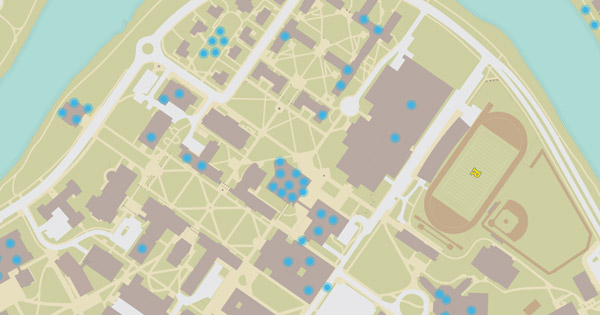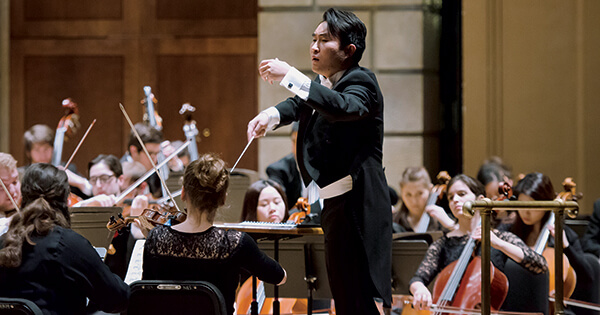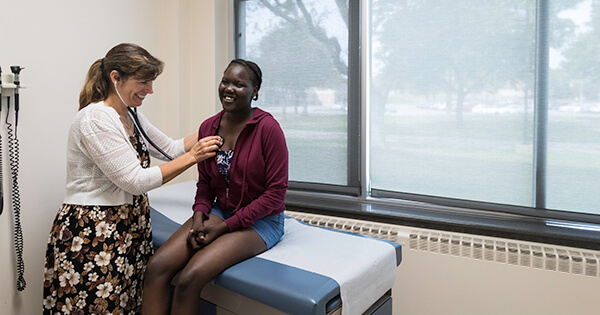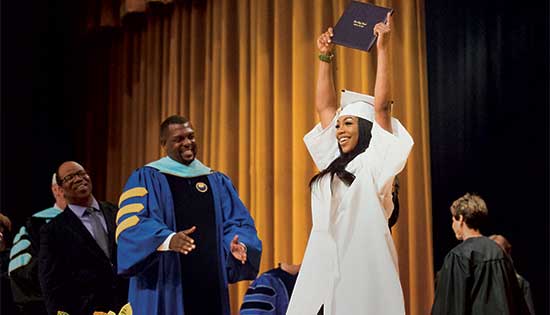Nobel Prize: Rochester laser science breakthrough
Nobel Prize: Rochester laser science breakthrough
A University of Rochester graduate and a former faculty member shared the Nobel Prize in Physics in 2018 for work they undertook at the University’s Laboratory for Laser Energetics (LLE).
Donna Strickland, who received her doctorate in optics from Rochester in 1989 and is now a professor at the University of Waterloo in Ontario, and Gérard Mourou, a former engineering professor and scientist at LLE and currently a professor at the École Polytechnique in France, were recognized for their work to develop lasers as a high-powered tool that ultimately opened the door to new medical, scientific, and commercial applications. Known as “chirped-pulse amplification,” or CPA, the work was the basis of Strickland’s PhD dissertation at Rochester.
Strickland is only the third woman to receive the prize in physics, joining Marie Curie (1903) and Maria Goeppert-Mayer (1963). She is the first woman laureate in Rochester’s history.
“We need to celebrate women physicists because we’re out there,” Strickland said today after her prize was announced. “I am honored to be one of those women.”
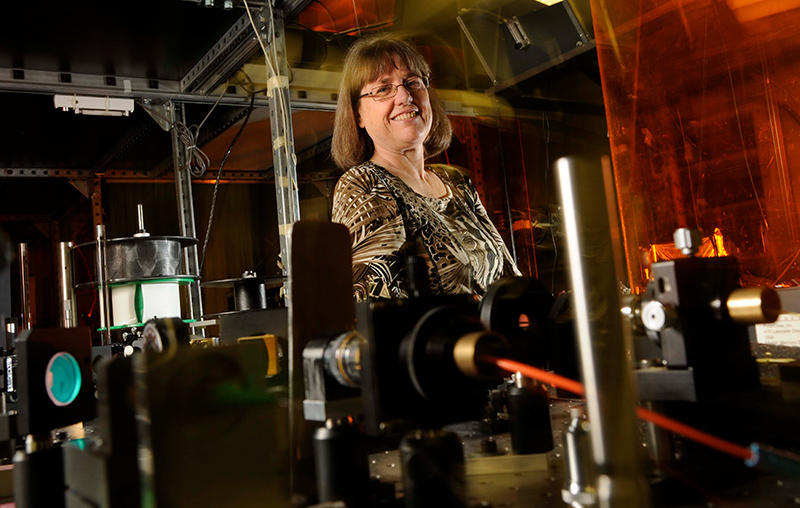
Mike Campbell, director of the LLE, said Strickland and Mourou have helped shape the direction of research in high-powered lasers of the kind housed at the Laser Lab.
“The development of chirped-pulse amplification by Gérard and Donna has created numerous new applications in science and industry and has catalyzed research around the world in high peak-power lasers,” he said. “The research that led to the Nobel was conducted at the Laboratory for Laser Energetics and highlights the quality and innovation that has long characterized the University’s contributions to optics and laser science. All of us extend our sincere congratulations to Gérard and Donna for their pioneering and impactful research.”
“The University of Rochester community is immensely proud to hear that the Nobel Prize in Physics has been awarded to our alumna Donna Strickland and her professor and graduate advisor, Gérard Mourou, for research conducted at the University’s Laboratory for Laser Energetics during her graduate studies here,” said University President Richard Feldman. “We are honored to count them among the Nobel Laureates connected to the University of Rochester and send them sincere congratulations on this recognition and on their career achievements in physics.”
In 1985 Mourou and Strickland demonstrated what has been described as a stunning advance in laser power, with a table-top terawatt laser, or “T-cubed laser.” Until then, the peak power of laser pulses was limited because of the serious damage the pulses caused to the material used to amplify them. Mourou and Strickland worked together to overcome the problem, developing the groundbreaking CPA technique, which involves three steps:
- Stretching the laser pulse thousands of times
- Amplifying the pulse in a laser material without damaging it
- Recompressing it in time back to its original duration
The breakthrough paved the way for creating very short and very intense laser pulses lasting only a fraction of a second, making it possible to build more compact and precise laser systems. The CPA technique has been used in a variety of applications, from Lasik eye surgery to the manufacturing of materials used in smartphones.
“This is a great day for optics and a wonderful recognition of the deep impact optics has across science and engineering,” said Scott Carney, director of Rochester’s Institute of Optics. “CPA has opened the door to a treasure trove of science. Without this incredibly powerful and elegant invention, we would still be living in a nanosecond world rather than exploring the physics of femtosecond dynamics that happen a million times faster. Professor Mourou and Professor Strickland’s work has had impact in fields from chemistry to atmospheric science, from nonlinear quantum electrodynamics to laser-driven manufacturing. This recognition is well-deserved.”
Wayne Knox, professor of optics and former Institute of Optics director, was Mourou’s first PhD student and worked in his Ultrafast Laser Group. Mourou is “one of the most visionary and creative people I’ve met in my whole life,” Knox said. “He was always thinking about the next power of 10. If his laser was making 1018 watts per square centimeter, he wanted to build one that was a thousand times bigger.”
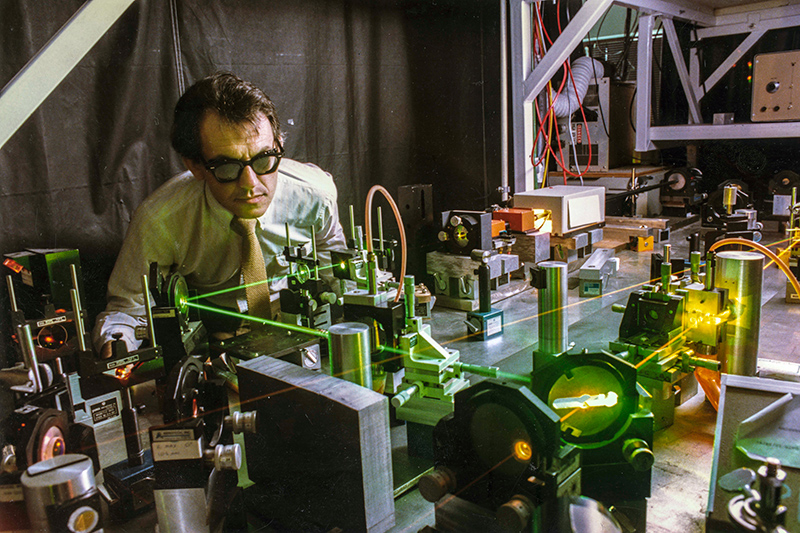
In addition to Strickland and Mourou, the Nobel committee announced the other half prize went to American scientist Arthur Ashkin for his work to create “optical tweezers,” a method of using lasers to cool atoms to a temperature where they can be studied individually. Based on work done at Bell Laboratories, the research included contributions by Rochester graduate Steven Chu ’70, who went on to win his own Nobel Prize in Physics in 1997.
In an interview for the Nobel website, Strickland said she drew on research by Goeppert-Mayer as part of her own work, but that she wasn’t sure how to put into context the idea that she was only the third woman to be recognized in physics.
“I’m glad there were trailblazers like Maria Goeppert-Mayer and Marie Curie,” she said. “She (Goeppert-Mayer) didn’t have a paid job for a long time or get to be recognized as a scientist, even though she was doing incredible work. The work I cite from her in my thesis started the whole field of multi-photon ionization, which was the first thing our laser was used for. That work was done in 1939. It’s not like she won the Nobel Prize for it, but it totally changed what could be done. You think, how can you go more than 20 years? Not to get a Nobel Prize but just to even be recognized as a scientist. I think things have totally changed.”
Strickland and Mourou are Rochester’s 10th and 11th Nobel Prize recipients. The most recent was Richard Thaler ’74 (PhD), the Charles R. Walgreen Distinguished Service Professor of Behavioral Science and Economics at the Booth School of the University of Chicago, who received the 2017 Nobel Prize in Economic Sciences.
David Williams, dean for research for Arts, Sciences & Engineering and director of the Center for Visual Science, said that in selecting Strickland and Mourou, the committee gave recognition to the role of universities such as Rochester in bringing together students and teachers to advance knowledge.
“That Strickland and Mourou received the Nobel Prize in Physics for an invention achieved as a graduate student working with her mentor at the University of Rochester is the best possible example our global leadership in both research and education in the field of optics,” Williams said.
Created in 1970 at the University, the LLE is recognized as a world leader in an effort to investigate whether powerful lasers can compress atoms to induce nuclear fusion and as a leading center for the study of high-energy-density physics, an exploration of matter under pressures that can only be found in stars and in large planets.
As a result of federal and state support, the LLE has attracted more than $2.3 billion since its inception to support cutting-edge research—including support for Strickland and Mourou’s work. In September, Congress authorized $80 million for LLE as part of funding for the Department of Energy’s 2019 fiscal year. The figure represents a $5 million increase over last year and the highest level of federal funding ever appropriated to the LLE in the University’s history.


